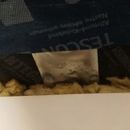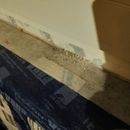Condensation on window installation straps
Zone 5 / NE Ohio (currently <10F outside)
The Setup:
In my retrofit, I installed triple-glazed windows from Inline Fiberglass. The frames are fiberglass, with aluminum profile jamb extensions on the exterior. They are installed with galvanized metal straps, ~2″ wide, that are screwed through the aluminum jamb extension to window frame profile toward the outside edge of the window using a single self-tapping screw, shimmed, and screwed to the rough framing on the interior side.
Using various Proclima tapes, the rough opening has Extoseal at the sill and Contega Solido Exo at the jambs and head, the window is taped to the exterior of the opening with Solido Exo or IQ all around, and for interior air sealing I’ve experimented with either foam backer rod & Contega HF sealant or with more Contega tape. The space between the window frame and rough opening is generally around 1/4″ – 3/4″ and gets stuffed with mineral wool insulation.
The Situation:
Tonight I was working on the 2nd floor, and noticed that one of the windows which has been installed but not yet insulated or sealed at the interior had a pretty substantial amount of condensation around the edges. This was unsurprising. However, I looked at another window that has been insulated and sealed, and found it, too, had condensation on the interior of the tape over the mounting straps. I had worried a bit about thermal bridging from these straps when I saw that they were fastened to the aluminum window jamb extensions, which are directly exposed to the exterior environment, but I figured Inline deals with colder climates than I am in and knows what they’re doing — the straps were installed with a “thermal break tape” (some slightly foam-y tape ~1/16″ thick) between the straps and the window. Apparently, however, there is enough of a thermal bridge to make them cold enough to condense water at the interior.
The interior conditions are currently in the realm of 65-70F, 50-40% RH (dew point temperature estimated ~45F). This is perhaps moister than many houses run, but it doesn’t seem excessively or abnormally moist, and I hope the answer isn’t just “your house is supposed to by dry AF in the winter!” It’s also worth noting that this is with the window openings fully exposed to interior ambient conditions; eventually the openings will have wood trim installed, making the mounting strap area if anything colder but also potentially slowing air circulation / vapor exchange.
The questions:
So, how much do I worry about this? I can think of a few possible reactions to my observations, which seems most reasonable to those more experienced?
1. This is a transient condition caused by abnormally cold exterior temps. In the finished house, there will probably be minor amounts of condensation on rare occasions, but it’ll dry out and won’t matter.
2. The window trim will on its own sufficiently limit airflow and vapor diffusion from the room into the area between the trim and the rough framing, so there won’t be enough moisture in that small gap to form any notable amount of condensation around the mounting straps.
3. Excessive condensation is a possibility, and I should either install thin pieces of rigid foam around the interior before installing the trim, or fill the space between the rough opening and the window casing with canned foam, to provide an additional thermal break and prevent interior air from reaching the cold window straps.
4. Hopefully nothing that involves more serious re-doing of window installations!!
Photos of window straps attached.
GBA Detail Library
A collection of one thousand construction details organized by climate and house part












Replies
Bumping this because I posted late at night and I know people here have thoughts about condensation! ;)
That is an unfortunate design as you're pretty much locked into that thermal bridge at this point. The only option for an in place fix is going to be to prevent interior air getting to the strap. In your position I would try closed cell low expansion foam to insulate the gap, or use backer rod and sealant first. If you see condenstation, then I'd consider insulating the strap itself before the interior trim goes on, or drywall return if you're going that route.
The Inline units I've installed had clips that click into a slot on the fiberglass extrusion, don't know why your attach to the aluminum. Not the best idea.
You definitely want some insulation that is non air permeable over the straps. A combination of a couple of layers of foam tape and canned foam should do it. The trim and drywall will not help at all in this case.
Leaving it as is is a bad idea. Even if you did get your RH lower, these will still sweat in cold weather which will damage things in the long run.
I got a few windows from Inline without exterior frame extensions that did have the straps that snap into the fiberglass extrusion, but the exterior frame extension partially covers the fiberglass on the sides and it looks like their solution for this is to supply the straps screwed to the aluminum.
By "foam tape" are you thinking of something like the closed-cell rubbery stuff sold as pipe insulation wrap (ie Armacell this stuff: https://www.armacell.us/fileadmin/user_upload/Insulation_Submittals-English/AP_ArmaFlex_InsulationTape.Sub.EN.US.2020.pdf)?